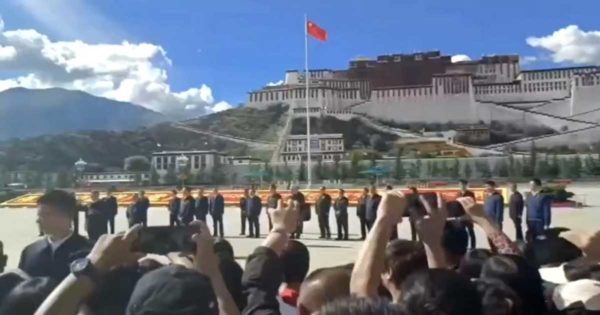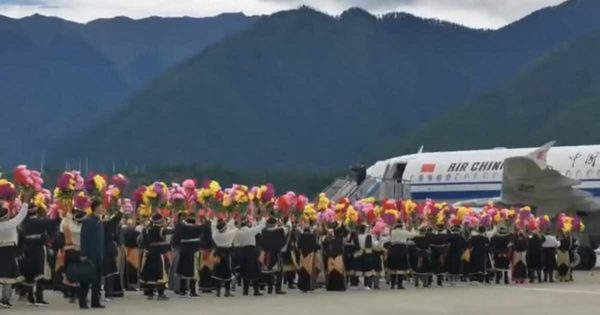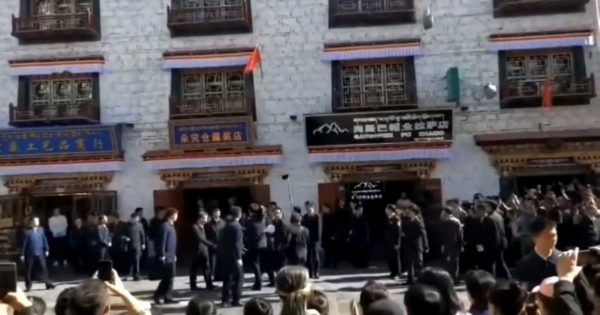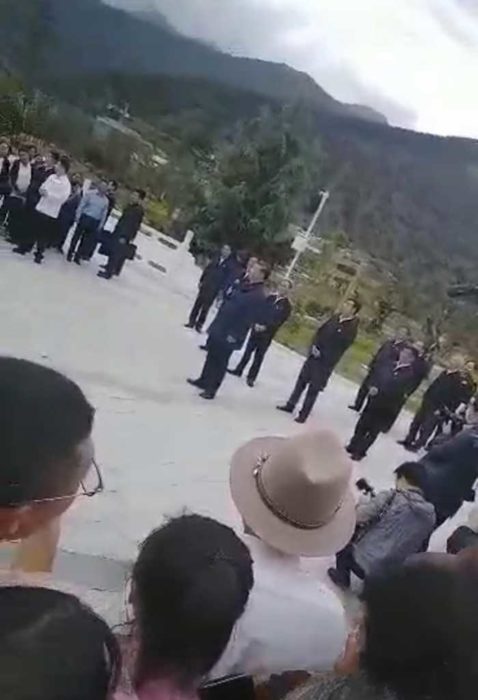
Chinese President Xi Jinping delivers a speech facing the “Monument of Peaceful Liberation of Tibet” (not captured in the image) at the Potala square in Tibet’s capital of Lhasa.
Chinese President Xi Jinping has made an unannounced visit to Tibet. Video clips shared on Chinese social media today show Xi addressing people in the city of Nyingtri (Chinese: Linzhi), stepping out of a shop in the Barkhor area in Lhasa and giving remarks to the public while facing the “Monument to the Peaceful Liberation of Tibet” in front of the Potala Palace, the traditional winter residence of the Dalai Lama.
A recent official notice announcing the closure of the Potala on July 22 indicated a visit by a high-level dignitary, but the fact that Xi was visiting caught many observers off guard. According to sources, the visit may have been linked to the 70th anniversary of the controversial 17 Point Agreement, which China falsely claims marks its “peaceful liberation of Tibet,” but which the Dalai Lama has renounced as an agreement made under duress.
A source told the International Campaign for Tibet that Xi first landed at Mainling airport in Nyingtri, in southeast Tibet, on July 20 [Note: Subsequently, the Chinese government announced that he had arrived on July 21]. Xi addressed a public gathering in Nyingtri, stating that 10 years ago, when he came as head of the Chinese government’s delegation to mark the 60th anniversary of the 17 Point Agreement, he had gone to Lhasa first. But this time, he said, he came to meet the people in Nyingtri first, telling them that not a single ethnic group should be left behind in the efforts to fully build a modern socialist China. Xi said that the public should work for the rejuvenation of China and the next 100 years of the Chinese Communist Party.
Xi was also seen addressing a gathering in front of the Potala Palace in Lhasa, where he stated that “as long as we follow the Communist Party and as long as we stick to the path of socialism with Chinese characteristics, we will surely realize the great rejuvenation of the Chinese nation as planned.”
A source told ICT that Xi may also visit one of the monasteries in Lhasa, possibly Drepung Monastery, during this trip.
Three separate sources told ICT that their acquaintances in Lhasa reported unusual activities and monitoring of their movement in the past several days, indicating the visit of an important leader. People reported receiving calls from security officials checking on their activities for no apparent reason. Roads in several sections of Lhasa were blocked, and the Lhasa City authorities announced the banning of drones and kites in Lhasa from July 21 to Aug. 17.
While heavy security is expected for a visit by Xi anywhere, it is unusual that even Chinese state media did not report about his visit to Nyingtri and Lhasa, even though two days have already passed since his arrival.
Xi last visited the Tibet Autonomous Region—which spans about half of Tibet—in 2011 when he was China’s vice president. At the same, he visited Lhasa, Nyingtri and Shigatse.
ICT quote
The International Campaign for Tibet, a Washington, DC-based advocacy group, said: “Chinese President Xi Jinping’s visit to Tibet is an indication of how high Tibet continues to figure in Chinese policy considerations, given that the visit is connected to the 70th anniversary of the falsely claimed ‘peaceful liberation’ of Tibet. Severe floods were impacting China’s Henan province even as Xi was in Tibet. However, the way in which the visit was organized and the complete absence of any immediate state media coverage of the visit indicate that Tibet continues to be a sensitive issue and that the Chinese authorities do not have confidence in their legitimacy among the Tibetan people.”

Screengrab of Xi Jinping’s arrival at Mainling Airport in Nyingtri on July 20.

Screengrab of Xi Jinping stepping out of a shop in Lhasa’s Barkhor on July 22.

Screengrab of Xi giving a speech to the assembled public in Nyingtri.

